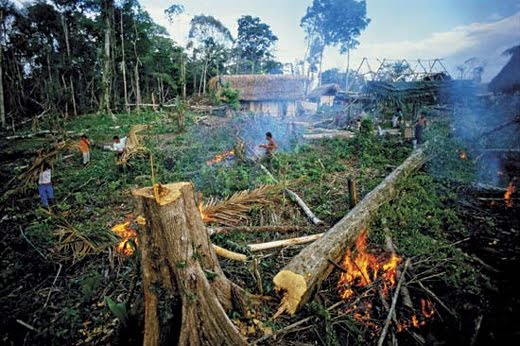 The problems and imbalances and enhance each other, threatening the survival of the human species. A clear example of this is another essential tool in reverse: that of the forest. In the past 100 years the world has lost almost half its forest area. And, as indicated by reports of the FAO (Food and Agriculture) the Earth is losing on net every year 11.2 million hectares of virgin forest.
The problems and imbalances and enhance each other, threatening the survival of the human species. A clear example of this is another essential tool in reverse: that of the forest. In the past 100 years the world has lost almost half its forest area. And, as indicated by reports of the FAO (Food and Agriculture) the Earth is losing on net every year 11.2 million hectares of virgin forest.This is reportedly the World Wildlife Fund, mainly due to its use as an energy source (about 2000 million people worldwide depend on wood as fuel ) of agricultural and livestock expansion and mining and logging companies activities, often beyond control.
A report by the Brazilian government acknowledged in 1999 that 80% of the timber from the Amazon without a permit was obtained. And the tropical forest areas cleared in Africa correspond to species that take more than two hundred years to grow. One problem has been to add the deforestation that is causing Cotlan exploitation in Africa with great impact also on biodiversity.
This decline of forests, particularly serious in the case of tropical forests not only increases the greenhouse effect by reducing the absorption of carbon dioxide (see climate change) but also aggravated the decline of water resources: a As the dwindling forest cover, logically increases rainfall runoff, which favors the floods, soil erosion and reduces the amount that seeps into the ground to recharge aquifers.
Do not forget, moreover, that live in forests between 50 and 90 percent of all terrestrial species, so that its recoil is accompanied by a serious loss of biodiversity (Delibes and Delibes, 2005). And there are more problems arising from the reduction of forest cover, as they will facilitate access to forest roads to pick up lumber, etc., They become drier and more susceptible to fires, which further reduces more wooded area and this, in turn, makes less rainwater to seep into the ground … and that really opens a hellish spiral: there has never been as fires in recent years in the rainforests of Borneo, Java ,
Sumatra Deforestation … for the sale of wood and burning to prepare land for agriculture, coupled with spontaneous fires, came to form a column of smoke that spread over one million km2, which affected 70 million people in cities far away. The same has happened repeatedly in the Amazon rainforest.
And this is related to the loss of another natural resource: the arable land, just as we are at the time of rising food demand longest in history. This is another example of linking multiple problems. We, on the one hand, the impact of urban growth and the number of roads at the expense of fertile soils. Thus, since the eighties in China lost more than 400000 hectares of agricultural land each year due to booming construction and industrial growth, and the same applies to other Asian countries such as Korea, Indonesia and Japan, in which rapid industrialization devours farmland and, therefore, must import more than 70% of cereals consumed.






No comments:
Post a Comment